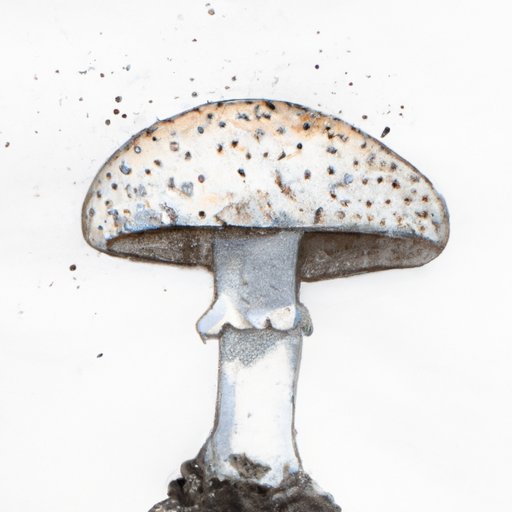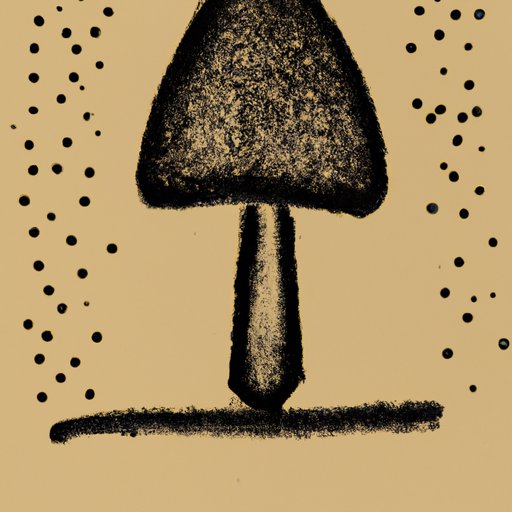I. Introduction
Are you a fan of mushrooms, both in nature and in art? Whether you’re an experienced artist or a beginner trying your hand at drawing, mushrooms offer endless inspiration and creative possibilities. In this article, we’ll be providing a step-by-step tutorial on drawing a mushroom, as well as exploring different mediums, shading and texturing techniques, and creative styles. From realistic to abstract, from naturalistic to symbolic, there’s a mushroom drawing style just waiting for you to discover. So let’s get started!
II. Step-by-step tutorial on drawing a mushroom
First things first, let’s break down the process of drawing a mushroom into easy-to-follow steps:
- Start with a rough sketch of the mushroom’s overall shape and size.
- Add the stem, making sure it’s proportional to the cap.
- Add the cap, keeping in mind the shape and texture of the mushroom you want to draw (e.g. flat or bulging, smooth or ridged).
- Add details like gills, spots, or veins to the cap or stem, depending on the type of mushroom.
- Erase any unnecessary lines and refine the overall shape.
- Finally, add shading and texture for depth and realism.
Remember to take your time and practice as much as you can. Playing with different shapes, sizes, and angles can help you master the art of drawing mushrooms in no time.
III. Using different materials to create a unique mushroom drawing
If you’re looking to add some color or unique texture to your mushroom drawing, consider experimenting with different art materials. Here are some materials that you can try:
- Watercolor: for a soft, dreamy effect
- Ink: for a bold and graphic style
- Colored pencils: for a more controlled and precise look
- Pastels: for a rich and textured finish
Take a look at some of the examples of unique mushroom drawings created with different mediums:

IV. Tips for adding shading and texture to the mushroom
Shading and texture are essential to creating a realistic-looking mushroom drawing. Here are some tips for adding depth and dimension using shading and texturing techniques:
- Use a range of tones: from light to dark, to create highlights and shadows
- Blend with a blending tool or your fingers to create a smooth transition between tones
- Use cross-hatching, stippling, or other techniques to create texture on the cap or stem
Take a look at these creative examples of shading and texture on mushroom drawings:

V. Breaking down the shapes and lines of a mushroom to make it easier to draw
Instead of trying to draw every detail of a mushroom, try breaking it down into simpler shapes or lines. This can help you focus on the most important aspects of the mushroom and simplify the drawing process. Here are some tips:
- Identify the basic shapes: for example, the cap could be a circle or oval, the stem could be a rectangle or cylinder
- Draw the basic shapes first, then refine them with more detail
- Look for the most distinct lines or curves of the mushroom, and use them as a guide for the rest of the drawing
Take a look at these simplified mushroom drawings to get a feel for this technique:


VI. Incorporating the mushroom into a larger piece of artwork
Mushrooms are versatile subjects that can be integrated into a variety of larger compositions. Whether you’re working on a landscape, a still life, or a whimsical illustration, a mushroom drawing can add a touch of charm and interest. Here are some ideas to get you started:
- Incorporate mushrooms into a forest or woodland scene, using tones and textures that blend in with the surroundings
- Add mushrooms to a still life composition, pairing them with other natural or man-made objects for contrast
- Create a fantasy or fairy tale illustration featuring mushrooms as a key element, using bright colors and bold shapes
Take a look at these examples of creative artwork that integrate mushroom drawings:

VII. Exploring the symbolism and meaning behind mushrooms in art
Mushrooms have a rich history of symbolism and meaning in art, from their naturalistic depictions in botanical illustrations to their symbolic representations in surreal and abstract art. Here are some insights into the cultural perspectives and meanings behind mushroom art:
- In Native American art, mushrooms are associated with the spirit world and used in vision quests
- In traditional Chinese art, mushrooms signify longevity and good fortune
- In contemporary art, mushrooms are often used as a symbol of transformation, decay, or surrealism
Take a look at some famous artworks featuring mushrooms and their meanings/symbolism:

VIII. Encouraging creativity by suggesting different styles and approaches to drawing a mushroom
Finally, remember that there’s no one right way to draw a mushroom. You can experiment with different styles, techniques, and approaches to find what works best for you. Here are some ideas to inspire your creativity:
- Try a more abstract or impressionistic style, focusing on colors and shapes rather than details
- Combine mushrooms with other natural or man-made elements to create a surreal or fantastical composition
- Use negative space to highlight the shape or texture of the mushroom, rather than drawing every detail
Remember, the most important thing is to have fun and enjoy the creative process!
IX. Conclusion
That concludes our step-by-step tutorial on drawing a mushroom and exploring different creative possibilities. We hope you found this article helpful and inspiring on your artistic journey. Remember, the key to mastering the art of drawing mushrooms is practice, patience, and creativity.
